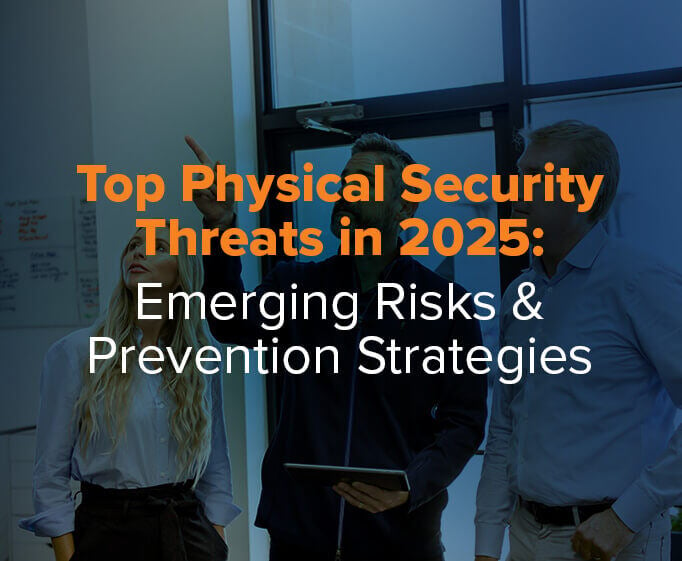By Jay Palter | October 25, 2023
In the era of digital-native business, data centers have become some of the most important infrastructure an organization must maintain. These facilities are the engine rooms of modern business, safeguarding data, applications, and critical business services.
Securing these facilities is vital. But when many business leaders think about data center security, their minds naturally go to network security. Only some consider the equally important physical security side of the problem.
This article investigates the challenges of data center physical security, what regulations you must consider, and why technologies support better physical security. It ends with some important best practices organizations of any size can follow. Whether you're a seasoned IT professional, security professional, or new to the world of data center management, this resource will equip you with the knowledge and strategies to bolster your center's physical security, including the innovative integration of smart lockers for keys and equipment.
Essential components of data center physical security programs
A robust physical security program ensures the integrity and reliability of your secure data center. Your program will need to include several key components. Some of the most common and effective measures fall into four main categories:
- Access controls
- Environmental controls
- Perimeter security measures
- Security personnel
Access controls
Access controls are the heart of data center physical security. They protect your facility against unauthorized access from bad actors and keep out the digital devices they might carry.
Security-conscious IT teams need to implement a multilayered system of access controls. That might mean implementing multiple checkpoints and requiring multi-factor authentication at physical access points, much as they would for network access controls.
Some of the most effective access control methods for data centers include:
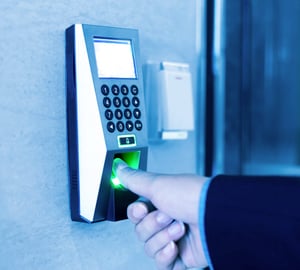
Biometric authentication
Biometric authentication methods, such as fingerprint and retinal scans, offer high levels of security for protecting data centers and other physical resources. They come at an increased cost but offer significantly stronger security than methods such as PIN codes, passwords, and other knowledge-based credentials that can be shared.
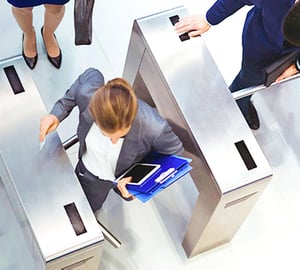
Card access systems
These systems require authorized personnel to swipe an access card at a secure reader. Modern access cards are difficult to replicate and enable you to monitor and manage who enters your facility.
Card access systems remain a common and effective token-based method of controlling entry. Unlike biometrics, which manage access based on an attribute of a user, card-based systems grant access based on something they have with them—a token.
Card access systems offer more flexibility and faster customizability than counterpart token-based systems, like physical key access control.
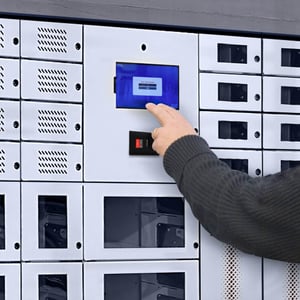
Smart lockers
First, we need to understand smart technology. Smart technology integrates computer systems and sensors, enabling them to monitor their environments and functions.
Smart lockers are advanced storage and distribution systems with an integrated computer and sensor network. These features enable smart lockers to adapt dynamically by controlling which assets are available for sign-out, identifying assets needing maintenance, and notifying you of any unusual sign-out patterns. They are an efficient means of device storage and tracking.
An authentication panel on a smart locker records user identities during asset sign-in and sign-out processes. Administrators gain precise control over sign-outs, allowing them to limit access on a user-by-user basis or within specific time frames. Additionally, smart lockers can promptly alert administrators if a user fails to return an asset on schedule.
Environmental controls
Good data center security involves more than just preventing unauthorized access. You must also protect your critical infrastructure against fire, floods, and natural disasters. These measures are collectively referred to as environmental controls. Two of the most common in data centers are fire suppression systems and temperature and humidity monitoring.
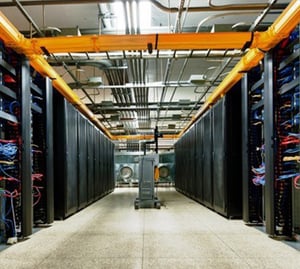
Fire suppression systems
Robust fire suppression systems protect your data center from potential disasters. These systems detect fires early and can alert emergency services. They also often extinguish them using various built-in methods, such as gas- or water-based suppression.
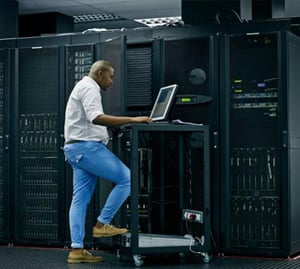
Temperature and humidity monitoring
Monitoring temperature and humidity levels ensures that sensitive equipment functions properly. Automated alerts notify administrators of deviations that could jeopardize the equipment.
Perimeter security measures
Managing access points is a critical component of perimeter security—in other words, protecting the outer boundary of your facility. But bad actors will want to attack more than just your access points. That is why a comprehensive approach to perimeter security is essential.
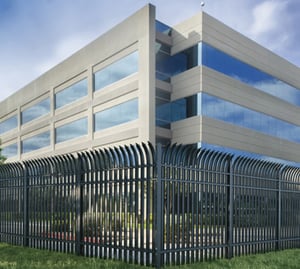
Fencing and barriers
Surrounding your data center with high, impenetrable fencing and security barriers creates a physical deterrent. These defenses make it challenging for unauthorized individuals to breach your facility.
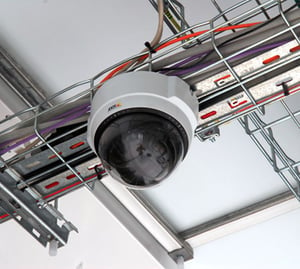
Surveillance cameras
Surveillance cameras are the remote, automated eyes and ears that monitor the data center perimeter. A well-planned surveillance network ensures constant vigilance and records any suspicious activities. Combined with access control systems, these cameras offer a comprehensive view of who enters and exits the facility.
Security personnel
While advanced technology plays a significant role in data center security, trained security personnel remain invaluable. They add a human element to security protocols, offering both deterrence and a rapid response to threats.

On-site guards
Having on-site security personnel provides an immediate response to threats. Trained guards not only offer a visible deterrent but are also capable of promptly assessing and addressing security breaches.
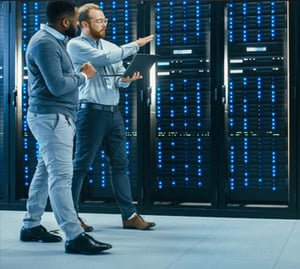
Security protocols
Stringent security protocols, implemented and adhered to by security personnel and other data center employees, are the backbone of your security strategy. Protocols ensure everyone on-site understands their roles and responsibilities in upholding security standards.
Incorporating these key elements into your data center's physical security strategy creates a formidable defense system that safeguards your critical infrastructure from external threats. By combining advanced technology with robust protocols and personnel, you can ensure the integrity and continuity of your data center operations.
Regulatory compliance & standards
Data centers hold vast amounts of sensitive information vital to the operation of modern businesses. Protecting this data from theft, breaches, or unauthorized access is a responsibility and, in many instances, a legal obligation. Several regulations and standards mandate data center operators to adhere to strict security protocols.
GDPR (General Data Protection Regulation)
GDPR is a European Union regulation that safeguards individuals' privacy and data protection rights. Data centers that process or store personal data belonging to EU citizens are bound by GDPR. Compliance with GDPR requires stringent data protection measures, including encryption, access controls, and data breach reporting.
HIPAA (Health Insurance Portability and Accountability Act)
HIPAA governs the security and privacy of healthcare data in the United States. Data centers that host healthcare information must comply with HIPAA standards, including robust access controls, data encryption, and strict audit trails to monitor data access.
SOX (Sarbanes-Oxley Act)
SOX mandates financial transparency and accountability in public companies. Data centers hosting financial data must adhere to SOX requirements, which often encompass stringent access controls and comprehensive audit trails.
FERPA (Family Educational Rights and Privacy Act)
FERPA protects student educational records in the United States. Data centers that manage these records must comply with FERPA regulations, which include strict access controls and data encryption.
CCPA (California Consumer Privacy Act)
The CCPA sets privacy rights and protection standards for California residents' data. Data centers serving California customers must comply with CCPA requirements, which include data protection measures and the right to erasure.
ISO 27001
The ISO 27001 standard provides a systematic approach to managing sensitive company information. Data centers that obtain ISO 27001 certification demonstrate a commitment to information security, encompassing risk assessment, access controls, encryption, and comprehensive security policies.
NIST Guidelines
The National Institute of Standards and Technology (NIST) offers cybersecurity and data security guidelines that are widely recognized and adopted. NIST guidelines encompass access control, encryption, incident response plans, and security risk assessments. Data centers adhering to NIST standards demonstrate a dedication to robust data security practices.
Best practices for data center physical security
No matter the size of your organization, following industry-standard best practices for data center physical security will improve its security posture.
Conduct regular employee training
Comprehensive employee training is the first line of defense against security threats. Regularly educate employees about the latest security threats, from phishing to social engineering. Make them vigilant in recognizing potential security risks.
Train staff on the importance of access control protocols. Ensure they understand the significance of proper badge management and the risks associated with tailgating or piggybacking through access control points.
Implement clear procedures for reporting security incidents or suspicious activities. Employees should also be aware of how to escalate concerns.
Implement proper access controls
Implement biometric authentication methods for critical access points, like fingerprint or retinal scans. Biometrics enhance identity verification and access control.
Use secure card access systems, employing multi-factor authentication where feasible. Regularly audit and update access privileges and immediately revoke access for departing employees.
Perform regular security audits
Periodic security audits are crucial for identifying vulnerabilities and areas for improvement. Conduct regular physical security audits to evaluate the effectiveness of security measures, from surveillance systems to access controls. Also, conduct vulnerability assessments to identify the data center's security infrastructure weaknesses. Address any shortcomings promptly.
Develop comprehensive incident response plans to address various security incidents, including breaches, physical breaches, and natural disasters. Regularly conduct drills and simulations of potential security incidents to ensure employees know how to respond to threats.

Streamline your data center operations with Real Time Networks.
See our Smart Locker Solutions & Key Management for Data Centers.
Subscribe to our blog

Jay Palter
Vice President of Marketing & Partnerships



